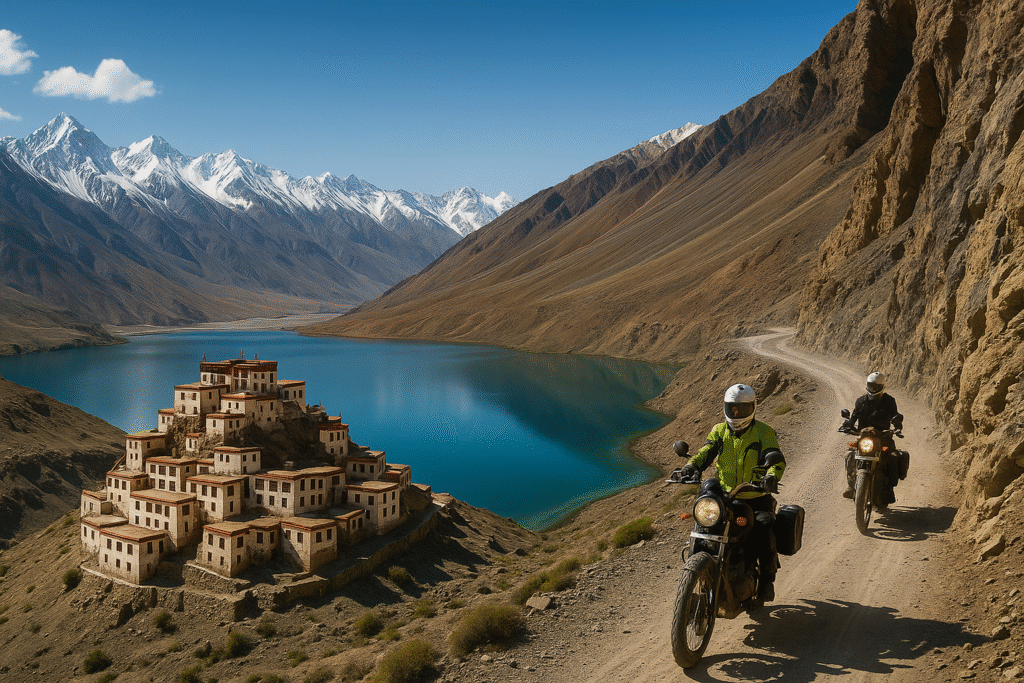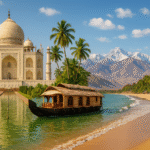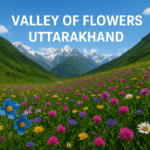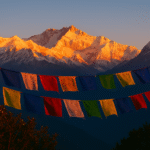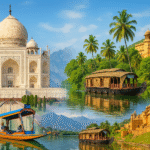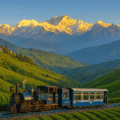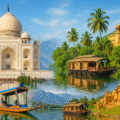If there is one place in India that feels like stepping onto another planet, it is Spiti Valley. A mystical land of snow-covered peaks, deep gorges, turquoise rivers, and centuries-old monasteries, Spiti offers an adventure that is both thrilling and spiritual.
Often called “The Middle Land” because it lies between India and Tibet, Spiti Valley is a remote, high-altitude desert in Himachal Pradesh. At an average elevation of 12,500 feet, Spiti is not just about breathtaking landscapes — it is about experiencing a slower life, ancient Buddhist culture, and raw Himalayan beauty.
Spiti Valley travel guide, we’ll explore every detail — from history and culture to how to reach, best time to visit, top attractions, food, accommodation, adventure, itineraries, and practical tips. By the end, you’ll be ready to plan your own unforgettable journey to this Himalayan wonderland. 🌟
📍 1. Where is Spiti Valley?
Spiti Valley lies in the northeastern corner of Himachal Pradesh, in the Lahaul and Spiti district, bordering Tibet.
- 🌍 Region: Trans-Himalayan zone
- 🏙️ Main Town: Kaza (administrative hub)
- 🏔️ Altitude: 10,000 – 15,000 ft above sea level
- 🌊 Main River: Spiti River, a tributary of the Sutlej
- 🇮🇳 Border Proximity: Shares culture and history with Tibet
The term “Spiti” means “The Middle Land” — signifying its geographical and cultural position between India and Tibet.
🌦️ 2. Geography & Climate of Spiti
Spiti is a cold desert because of its location in the rain shadow of the Himalayas. The valley is characterized by barren mountains, deep gorges, and snow-fed rivers.
📊 Seasonal Breakdown
- ☀️ Summer (May – September):
- Best time to travel
- Day: 15–20°C | Night: 5–10°C
- Roads open, all villages accessible
- 🍂 Autumn (October):
- Beautiful golden landscapes
- Nights get extremely cold
- ❄️ Winter (November – April):
- Freezing cold (-20°C and lower)
- Heavy snowfall, roads cut off
- Ideal for snow leopard spotting 🐆
👉 Tip: If you want comfortable travel and all places open, visit in June–September. If you love snow and extreme adventure, go in winter.
📖 3. History of Spiti Valley
🏯 Ancient Roots
- Spiti was once part of the Western Tibetan Kingdom of Guge.
- Monasteries like Tabo (996 AD) and Key Monastery are over a thousand years old.
📜 Medieval Period
- Controlled by local chieftains and Buddhist lamas.
- Trade route for salt, wool, and horses between Tibet and India.
🇮🇳 Modern Times
- Became part of India after independence.
- Still preserves its Tibetan Buddhist heritage.
🎭 4. Culture, People & Lifestyle
The people of Spiti are warm, simple, and deeply spiritual. Life is tough due to the altitude, but traditions remain strong.
👨👩👧 People & Language
- Ethnically Tibetan
- Language: Bhoti (Tibetan dialect)
- Also speak Hindi, some English
🎉 Festivals
- Losar (New Year): Colorful dances, rituals
- Chakar Festival: Held in monasteries
- Fagli Festival: Celebrated in February with fire rituals
👗 Traditional Dress
- Men wear woolen gonchas (robes)
- Women wear pangden (striped aprons) and ornaments
🧘 Spirituality
- Tibetan Buddhism is the heart of Spiti.
- Monasteries are centers of learning and meditation.
🛣️ 5. How to Reach Spiti Valley
There are two legendary road routes to Spiti. 🚗
🚗 Route 1: Shimla – Kinnaur – Spiti (All-Weather Route)
- Route: Shimla → Narkanda → Rampur → Reckong Peo → Kalpa → Nako → Tabo → Kaza
- ✅ Open almost year-round
- ⏳ 2–3 days drive
- 🌄 Scenic Sutlej river, apple orchards, Kinnaur
🚗 Route 2: Manali – Rohtang – Kunzum – Spiti (Summer Route)
- Route: Manali → Rohtang → Gramphu → Batal → Kunzum → Kaza
- ✅ Shorter, more adventurous
- ❌ Open June – October only
- ⏳ 1–2 days drive
✈️ By Air
- Nearest Airport: Bhuntar (Kullu), ~250 km from Kaza
🚆 By Train
- Nearest station: Shimla narrow-gauge line
👉 Pro Tip: Enter via Shimla, exit via Manali for a Spiti Circuit Road Trip.
🌟 6. Top Places to Visit in Spiti Valley
Spiti is full of magical places. Let’s explore in detail.
🏯 Monasteries of Spiti
- Key Monastery: Largest, 1000 years old, houses 300 monks
- Tabo Monastery: UNESCO candidate, murals & frescoes
- Dhankar Monastery: Cliffside beauty, ancient fort ruins
- Komic Tangyud Monastery: Among world’s highest
🏞️ Lakes & Natural Wonders
- Chandratal Lake: Moon Lake, crescent shape, great camping
- Suraj Tal: Near Baralacha La, sacred high-altitude lake
🏘️ Unique Villages
- Hikkim: World’s highest post office ✉️
- Komic: One of highest motorable villages
- Langza: Fossil village with giant Buddha statue
- Kibber: Base for snow leopard spotting
🌳 National Parks
- Pin Valley National Park: Snow leopards, ibex, wolves
🌉 Other Attractions
- Kunzum Pass (15,060 ft): Sacred gateway to Spiti
- Losar Village: Tranquil, traditional mud houses
- Mud Village: Base for Pin Valley treks
🐆 7. Wildlife & Nature
- Snow Leopard – Spiti is a hotspot for winter expeditions
- Siberian Ibex – Seen in Pin Valley
- Blue Sheep (Bharal) – Common in rocky slopes
- Himalayan Wolf – Rare but found in Spiti
- Flora: Medicinal herbs, seabuckthorn berries
👉 Spiti is a biodiversity treasure of the Himalayas.
🏕️ 8. Adventure Activities
- 🚵 Mountain Biking: Kaza–Manali circuit
- 🥾 Trekking: Pin-Parvati Pass, Spiti–Ladakh trek
- ⛺ Camping: Chandratal, Dhankar
- 🌌 Stargazing: Zero light pollution, astrophotography heaven
- 🌊 River Rafting: Spiti River adventure
🍲 9. Food in Spiti
Local food is simple, warm, and influenced by Tibet.
- 🍜 Thukpa – Noodle soup
- 🥟 Momos – Dumplings
- 🍞 Tingmo – Soft bread
- 🧈 Butter Tea – Salty yak butter tea
- 🍺 Chhang – Barley beer
🏨 10. Accommodation in Spiti
- 🏠 Homestays: Best cultural experience (Langza, Kibber, Komic)
- 🏨 Hotels/Guesthouses: Available in Kaza, Tabo
- ⛺ Camping: Chandratal & Pin Valley
🗓️ 11. Best Time to Visit
Month-Wise Guide
- May–June: Best weather, snow melts
- July–Sept: Lush green, perfect road trips
- Oct: Golden landscapes, very cold nights
- Nov–March: Snowbound, extreme cold, snow leopard treks
🗺️ 12. Suggested Itineraries
7-Day Circuit Itinerary
Day 1 – Shimla to Kalpa
Day 2 – Kalpa to Nako
Day 3 – Nako to Tabo, Dhankar
Day 4 – Kaza (Key, Kibber, Langza, Hikkim, Komic)
Day 5 – Pin Valley
Day 6 – Chandratal camping
Day 7 – Manali return
10–14 Day Extended Itinerary
- Explore more villages, treks, Pin Valley, snow leopard expedition
🎒 13. Packing Guide
- 🧥 Heavy woolens, thermals
- 🕶️ Sunglasses, sunscreen
- 💊 AMS medicines
- 🔋 Power banks, torch
- 📸 Camera & lenses
ℹ️ 14. Travel Tips
- 🚑 Acclimatize properly
- 💰 Carry cash (ATMs unreliable)
- 📶 BSNL/Jio only networks
- 📜 Permits needed for foreigners
- ♻️ Be eco-friendly, no plastic
📸 15. Photography Tips
- Best light: Sunrise & sunset
- Carry tripod for Milky Way shots
- Use wide-angle lenses for landscapes
- Villages like Langza & Kibber perfect for astro shots
🔄 16. Spiti vs Ladakh
- Spiti: Smaller, raw, less touristy, deeper cultural immersion
- Ladakh: Bigger, more developed, famous monasteries
👉 Both unique, but Spiti is quieter and more intimate.
❓ 17. FAQs
Q: Is Spiti Valley safe?
👉 Yes, very safe, crime negligible.
Q: Do I need a permit?
👉 Indians – no. Foreigners – Inner Line Permit.
Q: Can I take kids?
👉 Yes, but avoid very young children (altitude issues).
🌟 18. Why Visit Spiti?
Because Spiti is not just a destination — it’s a soulful journey. You’ll find peace in monasteries, thrill on rugged roads, joy in local smiles, and awe under the starry sky.
Spiti is where adventure meets spirituality.
